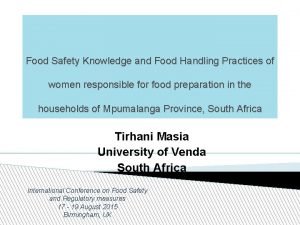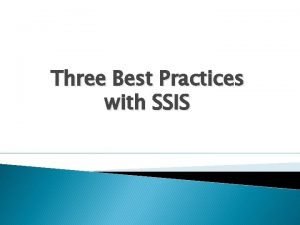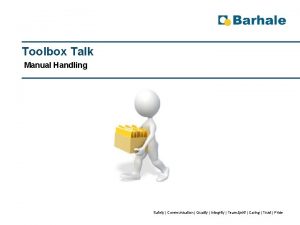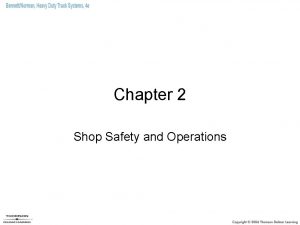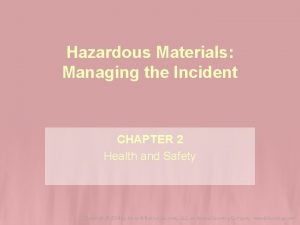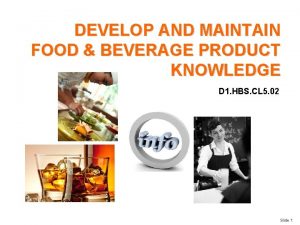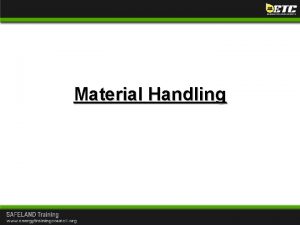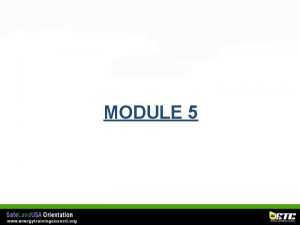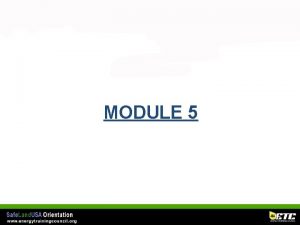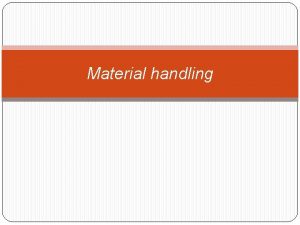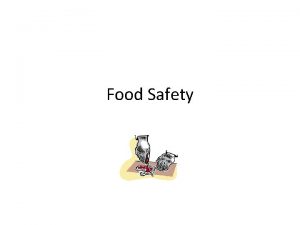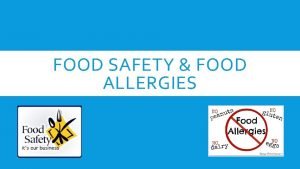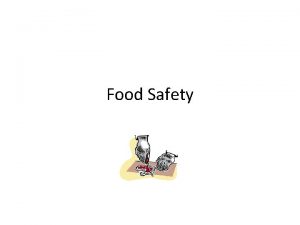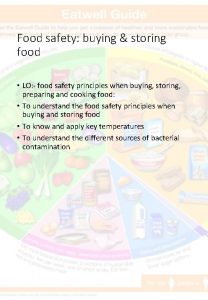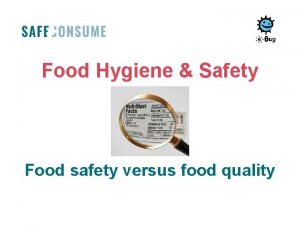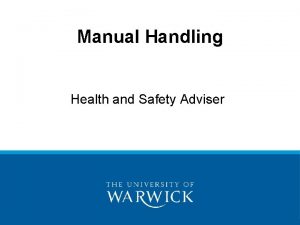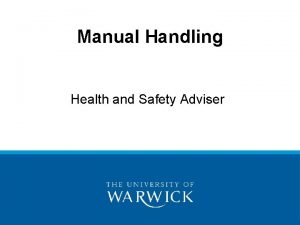Food Safety Knowledge and Food Handling Practices of




















- Slides: 20

Food Safety Knowledge and Food Handling Practices of women responsible for food preparation in the households of Mpumalanga Province, South Africa Tirhani Masia University of Venda South Africa International Conference on Food Safety and Regulatory measures 17 - 19 August 2015 Birmingham, UK

Structure of the Presentation Background information Methodology Results - Food safety knowledge - Food safety practices Discussion Conclusion & recommendations Acknowledgements

Background information Food safety is a global health goal and foodborne illnesses are among the most widespread public health concern. Millions of South Africans contract food poisoning every year (WHO, 2007) and people are dying from diarrheal diseases, especially children under the age of three years. Approximately 332 food poisoning cases were reported in Mpumalanga Province in 2008 and increased by 72% in 2009 (Do. H, 2009). The global incidence of foodborne illnesses is difficult to estimate, even in South Africa because most of the cases are rarely reported.

Background cont. …. Fein at al. (1995) reported that foodborne illnesses result from foods which are prepared outside home and showed that it results from foods prepared at home. WHO (2002) However, Do. H (2009) indicated that the issue is not about the place where food is prepared, but could be attributed to contamination of food and drinking water due to improper food handling practices, poor personal hygiene and poor sanitation. Foodborne illnesses can be prevented only if food safety procedures are followed from production to consumption.

Background cont. . . Studies revealed that consumers have inadequate knowledge and improper food handling practices. The main focus of this study was on women responsible for food preparation at household level. - assess their level of food safety knowledge and - food handling practices

Methodology Design & techniques - Descriptive cross-sectional study - Quantitative & qualitative Study population & Sampling - Simple randomly sampling: 60 households - Convenient sampling: 60 women (Interview) - Simple random sampling: 12 women (observation) Data collection methods - Researcher administered questionnaire (Face-to-face interview)

Analysis SPSS (version 22) for quantitative Data was interpreted in percentages Thematic analysis for qualitative data Likert scale was used to assess the level of knowledge Score Interpretation 0– 5 Limited knowledge 6 – 10 Satisfactory knowledge 11 Adequate knowledge q Chi-square q Ethical procedures were followed.

Study area in Mpumalanga Province

Results Demographic Age (years) • 20 and below • 21 – 30 • 31 – 40 • Above 40 Educational level • Never attended • Primary • Secondary • Tertiary Employment status • Unemployed • Domestic workers % 1. 7 50. 0 26. 7 21. 7 6. 7 58. 3 33. 3 91. 7 8. 3

Household characteristics Characteristics % Source of fuel for cooking Electricity Firewood Electricity and firewood Coal 26. 7 40. 0 31. 6 1. 7 Source of water Communal tap Own borehole 96. 7 3. 3 Types of livestock Chicken Ducks Cattle Goat Sheep Pigs 30. 0 15. 0 11. 7 8. 3 6. 7 3. 3 Toilet facility Ventilated toilet Flush toilet 85. 0 15. 0 Dumping hole Yes No 91. 7 8. 3

Appropriate responses relating to food safety knowledge Food safety knowledge statements % 1. Washing hands with soap and water before cooking and eating 91. 7 2. Cooked meat are left at room temperature for less than two hours 3. Iced cooler box cools down hot foods and keep them safe for hours 4. Microwave is safe to defrost meat or chicken 8. 3 16. 7 5. Preparatory surface areas to be clean before preparing food 73. 3 6. Washed fruit and vegetables before use 28. 3 7. Frozen foods are pick last during shopping 28. 3 8. Best before date or expiry date shows safety of food for consumption 81. 7 9. Wash cutting board with soap and rinse in hot water to kill bacteria 45. 0 28. 3

Level of food safety knowledge Test score % (n) Interpretation 0– 4 41. 7 (25) Limited knowledge 5– 8 53. 3 (32) Satisfactory knowledge 9 – 10 5. 0 (3) Adequate knowledge

Appropriate responses of food handling practices Questions Appropriate responses % How do you wash your hands before cooking or eating? With soap and water 56. 7 How do you defrost frozen meat or chicken? Cold water and change it 26. 7 after 30 minutes During shopping when do you pick refrigerated or frozen meat? At the end of the shopping trip 35. 0 What do you do to your head when preparing Cover it food? What do you do to your kitchen before preparing food? Clean it 54. 0 How often do you empty the garbage been? Daily 20. 0 How do you check if milk is safe for consumption? Expiry date 80. 0 Where do you store raw meat or chicken in the refrigerator, not freezer? Lower shelf 71. 7 What do you do to a knife that was used to cut meat before cutting vegetables? Wash with soap and water 26. 7 How do you prepare food with a sore at the back of Bandage the sore and 58. 3 16. 7

Food practices observational results § 12 women were observed Practices Mixed food in the refrigerator Stored food properly in the cupboard Cleaned the cooking area Head not covered during food preparation Head covered during food preparation Washed vegetables before preparation Defrost by immersing in cold water Wipe utensils with cloth before use Garbage area inside the yard n 5 2 10 10 3 4 8 7 8 9

Comparison results Chi-square was performed to determine the factors that influence food handling practices among women, Neither age, educational level nor level of food safety knowledge was found to have any influence.

Discussion Food handling practices were found to be appropriate in some areas and inappropriate in another. Studies shows that consumers often implement unsafe foodhandling practices during food preparations at their homes. Such practices need to be improved to reduce the risk and incidences of foodborne illnesses. Lack of food safety knowledge and negligence environmental contamination, poor social condition, inadequate personal hygiene practices and lack of safe food preparation facilities are interrelated factors that result to foodborne illnesses.

Conclusion & recommendations Foodborne illnesses can occur in the household and it is at this level that most corrective measures can be made. Community health professionals are in constant interaction with the public and are reliable resources to persuade people to adopt desirable habits as regards food safety. It is important for these professionals to be knowledgeable on food safety and proper food handling to be able to educate the public. Home-based caregivers should be trained to be able to assist during home visits.

Conclusion & recommendations. . . Since WHO is in partnership with other stakeholders in developing policies to promote safety of food, it is upon us to appropriately implement theses policies. The policies covers the entire food chain from production to consumption. The food safety programmes should strengthen food safety systems and educate consumers about appropriate food handling. Foodborne illnesses is common and can be prevented only if consumers can stick to preventive measures: - safe food keeping, storage & preparation good personal hygiene practices.

Acknowledgements University of Venda Community leader of Mangweni village Women who participated

I thank you for your attention Tirhani Masia School of Health Sciences Department of Nutrition Tirhani. masia@univen. ac. za
 Improper food handling practices
Improper food handling practices Retail cash handling best practices
Retail cash handling best practices Good handling practices
Good handling practices Ssis error handling best practices
Ssis error handling best practices A way to prevent materials handling hazards is to ___.
A way to prevent materials handling hazards is to ___. Safety practices and sports injury management pictures
Safety practices and sports injury management pictures Manual handling
Manual handling Knowledge creation and knowledge architecture
Knowledge creation and knowledge architecture Chapter 2 safety practices
Chapter 2 safety practices Chapter 2 safety practices
Chapter 2 safety practices Control measures for physical hazards
Control measures for physical hazards What is shared knowledge
What is shared knowledge Knowledge shared is knowledge squared
Knowledge shared is knowledge squared Knowledge shared is knowledge multiplied interpretation
Knowledge shared is knowledge multiplied interpretation Contoh shallow knowledge dan deep knowledge
Contoh shallow knowledge dan deep knowledge Posteriori proposition
Posteriori proposition Book smarts vs street smarts
Book smarts vs street smarts Shared knowledge vs personal knowledge
Shared knowledge vs personal knowledge Gertler econ
Gertler econ Product knowledge food and beverage service
Product knowledge food and beverage service Basic food knowledge
Basic food knowledge
